However, the Yushan is vulnerable to Chinese air and naval missiles, he said.
China, with more than 340 warships, has the world’s largest navy, according to the Pentagon’s 2022 China Military Power Report.
The Yushan likely wouldn’t last long in a war with the Chinese, according to retired U.S. Marine Col. Grant Newsham, a senior researcher with the Japan Forum for Strategic Studies in Tokyo.
“But that’s not the point,” he said in a Jan. 14 email. “A good chunk of the US Navy and Air Force wouldn’t last long in an all-out fight with the Chinese either. You do a lot of things in peacetime that you wouldn’t do, or couldn’t do, in wartime.”
Amphibious ships can help Taiwan master joint operations and could train with the U.S. Navy and Marine Corps or even Japan’s amphibious forces, Newsham said.
Such vessels could assist in humanitarian and disaster-relief operations overseas, something that is important politically for Taiwan, he said.
Marines, which the Yushan would carry along with landing craft to move them ashore, are essential to Taiwan’s defense, Newsham said.
“Tough, well-trained, mobile troops – armed with long-range precision weapons (and any other weapons) are the last thing [the Chinese] want to deal with,” he said. “You can’t find them, you have a hard time killing (them), and they are coming at you from all directions. Taiwan needs more of them, and properly employed. And consider the effect on civilian morale to know you’ve got these kinds of troops in your military.”
U.S. Marine training for local forces on the island, confirmed by Taiwan President Tsai Ing-wen in October 2021 on CNN, isn’t at the scale needed to really have an effect, Newsham said.
The most useful thing the U.S. can do is train Taiwanese forces to defend the sea and air around their island using missiles, drones and mobile launchers, former Navy Capt. Jan van Tol said in an email Saturday.
Taiwan’s marines might play a role similar to that of U.S. Marine littoral regiments designed for sea denial, said Van Tol, a senior fellow at the Center for Strategic and Budgetary Assessments, a nonprofit defense-policy think tank in Washington, D.C.
The country should adopt a “porcupine” approach that would feature large numbers of shorter-range precision rockets, artillery, mortars and missiles, he said.
“Such systems would have far lower unit costs (than warships), but there would have to be many more of them, dispersed down to lower echelons of command, as the conceptual equivalent of ‘mobile minefields’ to greatly increase geographic or sea areas where [Chinese] forces would need to honor the potential threats and expend greater resources to counter them,” he said.
04.13 總統出席「海軍新型兩棲船塢運輸艦命名暨下水典禮」by Taiwan Presidential Office is licensed under
CC BY 2.0

